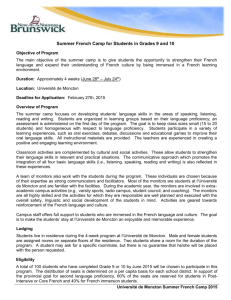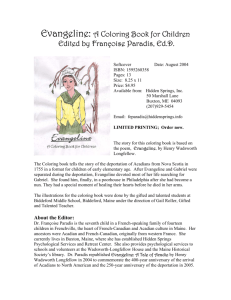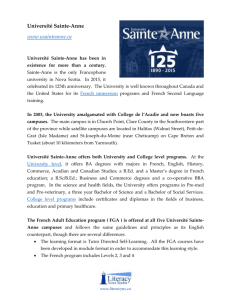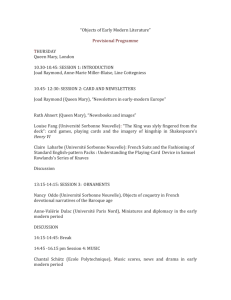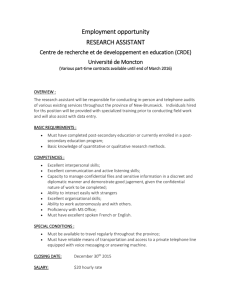In the Shadow of EVANGELINE 10 New Acadian Tales
advertisement
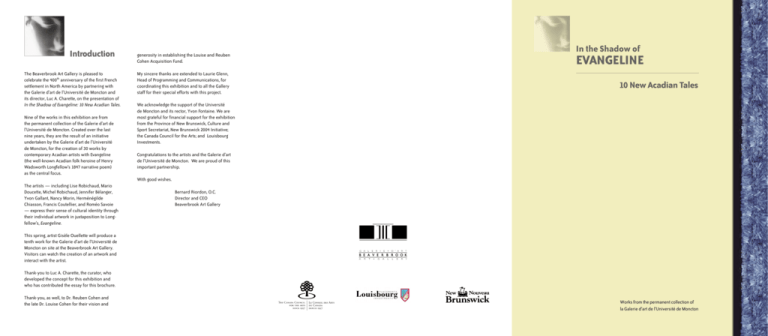
Introduction The Beaverbrook Art Gallery is pleased to celebrate the 400th anniversary of the first French settlement in North America by partnering with the Galerie d’art de l’Université de Moncton and its director, Luc A. Charette, on the presentation of In the Shadow of Evangeline: 10 New Acadian Tales. Nine of the works in this exhibition are from the permanent collection of the Galerie d’art de l’Université de Moncton. Created over the last nine years, they are the result of an initiative undertaken by the Galerie d’art de l’Université de Moncton, for the creation of 30 works by contemporary Acadian artists with Evangeline (the well-known Acadian folk heroine of Henry Wadsworth Longfellow’s 1847 narrative poem) as the central focus. generosity in establishing the Louise and Reuben Cohen Acquisition Fund. My sincere thanks are extended to Laurie Glenn, Head of Programming and Communications, for coordinating this exhibition and to all the Gallery staff for their special efforts with this project. In the Shadow of EVANGELINE 10 New Acadian Tales We acknowledge the support of the Université de Moncton and its rector, Yvon Fontaine. We are most grateful for financial support for the exhibition from the Province of New Brunswick, Culture and Sport Secretariat, New Brunswick 2004 Initiative; the Canada Council for the Arts; and Louisbourg Investments. Congratulations to the artists and the Galerie d’art de l’Université de Moncton. We are proud of this important partnership. With good wishes. The artists — including Lise Robichaud, Mario Doucette, Michel Robichaud, Jennifer Bélanger, Yvon Gallant, Nancy Morin, Herménégilde Chiasson, Francis Coutellier, and Roméo Savoie — express their sense of cultural identity through their individual artwork in juxtaposition to Longfellow’s, Evangeline. Bernard Riordon, O.C. Director and CEO Beaverbrook Art Gallery This spring, artist Gisèle Ouellette will produce a tenth work for the Galerie d’art de l’Université de Moncton on site at the Beaverbrook Art Gallery. Visitors can watch the creation of an artwork and interact with the artist. Thank-you to Luc A. Charette, the curator, who developed the concept for this exhibition and who has contributed the essay for this brochure. Thank-you, as well, to Dr. Reuben Cohen and the late Dr. Louise Cohen for their vision and Works from the permanent collection of la Galerie d’art de l’Université de Moncton at the university.3 In my opinion, it was time to put this “Made in the USA” heroine who has been part of Acadian heritage for 157 years, now, into a contemporary perspective. It was time to get out of the shadows cast by this emblematic figure, who has continued to shine with the brilliant rays of the southern sun. Evangeline . . . no other word, no other myth, has been more often used, exploited, worked, re-used, re-exploited, re-worked in our community during more than 150 years. Celebrated, idealized, glorified, but also more and more often questioned, criticized and denounced, the poem by American Henry Wadsworth Longfellow is, beyond a doubt, a premise for the creative work of Acadian artists; whether the artwork inspired by this theme serves to consecrate or contradict the myth.1 The context 1997 was an important year for Acadians, because it marked the 150th anniversary of the publication of the poem Evangeline, A Tale of Acadia. In his epic, the American poet, Henry Wadsworth Longfellow, recounts the story of two Acadian fiancés, Evangeline Bellefontaine and Gabriel Lajeunesse, who were separated during and as a result of the Deportation. A single thought directs the course of Evangeline’s entire life: that of finding her beloved Gabriel. She spends her life searching the western — central region of the United States, and at last finds him, an elderly man dying in a home. It is the orality, the telling, of the story of the Deportation of the Acadians (1755) that captured Longfellow’s imagination nearly a century after the event had taken place. The book, which was published in 1847, remains at the source of one of the most important Acadian myths in existence. It had the effect of awakening the nationalist consciousness at the end of the 19th century. The poem certainly inspired considerable literary criticism and history, but a much larger audience was attracted to this romantic tale. These two engravings are by Jane E. Benham from the Bell and Daldy edition of Evangeline, published in 1866. (Collection du Centre d’études acadiennes de l’Université de Moncton) “Even if we no longer have any remnants of the first Canadian feature film, Evangeline (1913)”2 there are more than 300 different editions and approximately 130 translations of the text. More than 160 artists have illustrated the literary work. Since they never set foot on Acadian soil, most of these artists had to rely on the rich descriptive passages of Longfellow’s poem. Evangeline often holds centre stage in depictions of the Deportation. In this way, fiction and reality are intertwined to the point that it is practically impossible to distinguish what is true and what is false. At the end of the poem, most illustrations show the elderly Gabriel to be frail and sickly, while Evangeline, despite her exhausting pilgrimage, remains as fresh and beautiful as if she were still a young girl. For Acadians in the 20th century, the symbol of Evangeline has crystallized over the years, in fine crafts, sculpture, imagery, costume, theatre, song, and the names of people and places. During the festivities celebrating the publication of the poem, the Art Gallery of the Université de Moncton undertook the development of this project in the summer of 1997. In the Shadow of Evangeline was designed in response to the major exhibition on Longfellow’s character by the Acadian Museum The project, as it was first conceived, would span a period of thirty years. Every three years, three artists would be invited to create, before the public, a large-format work (2,4 x 3,7 metres; 8 x 12 ft.) on the theme of Evangeline, divided into three names: Ève/Eve, Angèle/Angela and Line/Lyn, as well as variations that were added over the years: Ange/ Angel, Angélus/Angelus). The works created in this way would then be purchased with funds from the Louise & Reuben Cohen Trust for the Acquisition of Art for the Art Gallery of Université de Moncton’s collection. As a result of this initiative, the Acadian community would be able to have the good fortune of possessing a unique collection of major work created by most of the important contemporary artists of Acadie. Luc A. Charette March 2004 JENNIFER BÉLANGER Angèle, 2001 acrylic and collage on wood, 2,4 x 3,7 metres (8 x 12 ft) Cohen Collection, Galerie d’art de l’Université de Moncton (GAUM) HERMÉNÉGILDE CHIASSON Ange, 1997 acrylic and plastic figurines on wood, 2,4 x 3,7 metres (8 x 12 ft) Cohen Collection, Galerie d’art de l’Université de Moncton (GAUM) FRANCIS COUTELLIER Line, 1997 acrylic, photographs and objects on wood, 2,4 x 3,7 metres (8 x 12 ft) Cohen Collection, Galerie d’art de l’Université de Moncton (GAUM) MARIO DOUCETTE Évangéline, 2003 acrylic on wood, 2,4 x 3,7 metres (8 x 12 ft) Cohen Collection, Galerie d’art de l’Université de Moncton (GAUM) YVON GALLANT Évangéline, 2001 acrylic on wood, 2,4 x 3,7 metres (8 x 12 ft) Cohen Collection, Galerie d’art de l’Université de Moncton (GAUM) NANCY MORIN Ève et le jardin d’Éden, 2001 acrylic on wood, 2,4 x 3,7 metres (8 x 12 ft) Cohen Collection, Galerie d’art de l’Université de Moncton (GAUM) GISÈLE OUELLETTE (guest artist) untitled, 2004 Links Electronic version of the poem: www.umoncton.ca/gaum/Evangeline/Poeme/fr_word.zip Henry Wadsworth Longfellow: www.umoncton.ca/gaum/Evangeline/longfellow.html 1 CORMIER, Pénélope, “Évangéline décomposée,” L’Accent Acadien, L’Acadie NOUVELLE (Moncton), week of July 11 to 17, 2003, p. 6 2 NOVEK, David, “Point de vue. Pour la préservation de notre patrimoine audiovisuel,” Le Magazine Télé-Cinéma Primeurs, (Montréal), March 2004, vol. 13 no 2, p. 3. Note: Evangeline, a silent film directed by William Cavanaugh and Edward P. Sullivan was, according to information available, produced in 1914. Reference: http://us.imdb.com/title/tt0002832/ (dated March 17, 2004) 3 ROBICHAUD, Deborah (guest curator). L’Odyssée d’Évangéline, Musée acadien de l’Université de Moncton, 1997 acrylic on wood, 2,4 x 3,7 metres (8 x 12 ft) Created in situ in public view at the Beaverbrook Art Gallery. Collection of the artist LISE ROBICHAUD Angélus, 2003 ink, water-based dye, and varnish on wood, 2,4 x 3,7 metres (8 x 12 ft) Cohen Collection, Galerie d’art de l’Université de Moncton (GAUM) MICHEL ROBICHAUD Évangéline, 2003 acrylic, graphite, and ink on wood, 2,4 x 3,7 metres (8 x 12 ft) Cohen Collection, Galerie d’art de l’Université de Moncton (GAUM) ROMÉO SAVOIE Ève, 1997 acrylic, mixed media and objects on wood, 2,4 x 3,7 metres (8 x 12 ft) Cohen Collection, Galerie d’art de l’Université de Moncton (GAUM)
